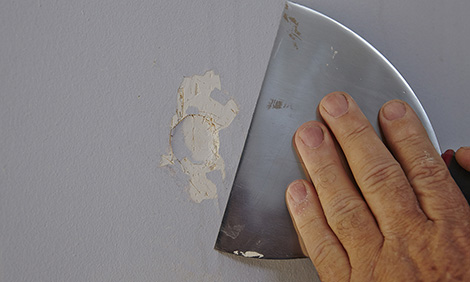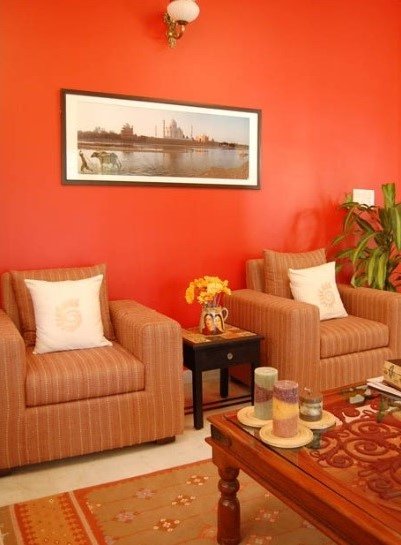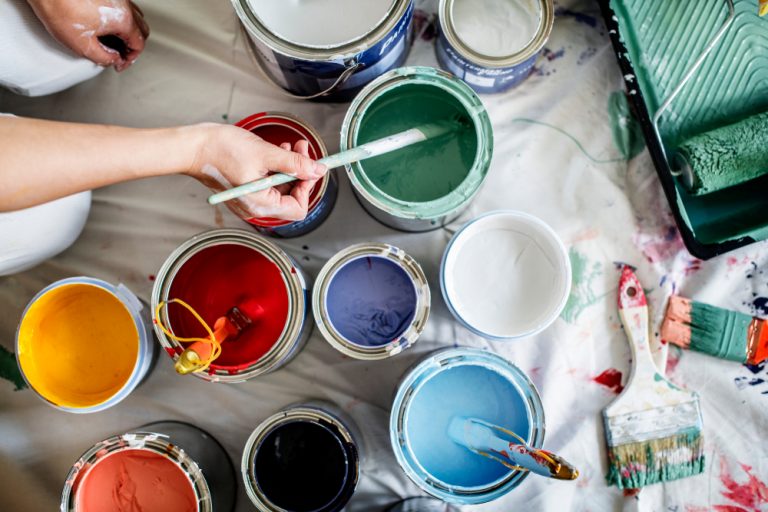Clean your walls
Making sure your walls are properly clean will help the paint to stick better. A clean surface also stops stains and marks showing through the new paint. For a good clean you need to use sugar soap. Mix up the sugar soap in a bucket of water according to the instructions on the bottle. Put on your gloves and thoroughly wash the walls using the sugar soap mixture. Once you’ve cleaned the wall, dry the sugar soap off using a rag.
Scrape cracked paint off the walls
After your walls have been cleaned and are dry, put on your safety glasses and dust mask and lay down a drop sheet near the wall. Use a paint scraper to remove any flaky and cracked paint from the wall. Use the ladder to reach spots higher up on the wall.
Apply gap filler to any cracks
Mix the powdered gap filler in a bucket with some water until it is the consistency of toothpaste. Using your paint scraper, apply it to all of the cracks and chips on the wall, making sure to overfill them. When your gap filler is dry, use sandpaper on a hand sander for a smooth finish.
Seal the gaps in the corners
Use a multi-purpose gap sealer and a caulking gun to fill the gaps in the corners of the walls. After applying the gap sealer, use a damp cloth to wipe off any excess. This will also make it smooth and push the filler it into the corners. You may need a second layer of gap filler to finish off. Now your walls are now ready to paint.
Tools
Caulking gun
Gloves
Hand sander
Ladder
Paint scraper
Materials
Coveralls
Drop sheet
Gap fillers
Sandpaper
Sugar soap
Water

How Much Does It Cost To Paint A Home Interior Or Room?
Interior Painting Cost Per Square Foot
Painting a home interior or room costs $2 to $6 per square foot with most jobs averaging $3.50 per square foot. Total painting project costs range between $961 and $2,771 with a national average of $1,803. For an entire 2,300 square foot home, expect to pay between $4,000 and $11,000. For a single room, you’ll spend anywhere from $200 to $1,000.
Painting is one of the quickest and easiest ways to give your home’s interior a facelift with dramatic results. Fortunately, it doesn’t have to be that difficult. Home improvement stores offer samples that you can take home. With these samples, you can try a few colors in large swaths on your wall to see the how the paint interacts with the room’s natural light. Compare it against design elements like pillows or furniture to see whether it will work with your overall décor.
Average Cost to Paint the Interior of a House
The average cost to paint a house interior ranges from $2 to $6 per square foot with an average of $3.30 per square foot. Painting trim, baseboards and ceilings will fall on the higher end of the cost range. Prepping the space by repairing drywall or plaster walls will increase project costs.
Home Interior Painting Costs
Painting the interior of an average 2300 square foot home runs anywhere from $1,900 to $7,800. Prices vary for a number of factors, including:
Regional differences. Higher regional wages and overhead means higher prices for you.
Wall height. High walls increase the paintable area.
Designer paints. You can pay up $1,000 more just for a better brand.
Apartment Painting Cost
Painting an apartment costs $1,000 to $2,900 for 950 square feet. If you own the apartment, all the costs fall to you. However, if you’re a renter, the landlord or owner might pick up some, or all, of the tab. Always talk to them first before picking up a brush or hiring a pro.

Your Beginner’s Guide to Wall Paint Colours (Costs & Concept Made Simple!)
absolutely love our colours, don’t we? Our homes are a testimony to that and for good reason, too! Because what colour can do to a space, nothing else can. Brand new wall paint colours, a fresh coat, or even home colour designs, have the power to not only infuse life into our space but to also affect our mood. Therefore, whether you’re moving into a new apartment or renovating your current abode, painting becomes a priority. However, it is more important that you make yourself aware of the know-hows of the painting world too to get the most out of your hired painter.
But we know what you’re thinking. “How do I pick the best paint combination for walls in my living room?” “Also, what kind of a finish should I opt for?” If these and more questions are troubling you, we’ve got your back. We’ve broken down the painting world to help you with all the home paints information you would ever need and to turn you into nothing less than a pro
The following easy-to-navigate mini guides will cover the following:
1. Picking the right wall paint colours.
2. Choosing the relevant type of paint.
3. Selecting the right paint finish.
4. Knowing the costs of wall painting.
5. Preparing your room and getting it painted.
PICKING THE RIGHT WALL PAINT COLOURS
That’s the first thing you and I would think of, right? Heck, one probably isn’t even thinking about the types of paints and finishes at this point. So, we’ll come to that later. Because narrowing down to your choice of colour is not an easy decision. Even if you do have, for instance, bedroom paint ideas in mind, you will always have those doubts clouding your mind.
CHOOSING THE RELEVANT TYPE OF PAINT
Now that you’ve narrowed down your choices to a selection of wall paint colours, it’s time to understand paints a tad bit — this will give you an idea of what works in Indian homes and, more importantly, in your apartment. First up, all paints are divided into two groups: Water-based paints and oil-based paints

THINGS YOUR HOUSE PAINTER WISHES YOU KNEW
Paint can literally transform a house and is usually one of the first projects under consideration by homeowners. Painting your home is not something you want to repeat every few years, so it is important to consider some relevant factors when contemplating the addition of new paint.
Have you ever wished you knew a really good, professional painter so you could ask them some candid questions? What would this trusted friend tell you about the painting process? What would he or she advise you to do or avoid at all costs? Consider this article your trusted friend, and pay close attention to the advice given
Good References Are Your Guide – Always ask prospective painting contractors for the names and phone numbers of satisfied customers. You can call these previous clients or you can read their testimonials online! A reputable company will always have some references and testimonials to share with you.
All Bids are Not Alike – Don’t be guilty of confusing price with value. Painting, even house painting, is an art, and cheap work shows. Many homeowners hire a wino-priced painting contractor and then expect a champagne job. You truly get what you pay for, and this is especially true when contracting professional services. Demand a complete estimate that includes everything in writing, including an explanation of preparatory steps, materials to be used, and painting procedures.
Demand a Worthy Warranty – Every painting job should have a signed contract and warranty that specifies what each party has agreed to do, before work begins. A warranty protects you from product failures or oversights and poor quality workmanship.

What Interior Paint Colours Help Sell Houses?
As you may have read in our recent post about things that devalue property, choosing the wrong colour scheme for your home can have a devastating effect on the price you may get when your property goes to market. So, if the wrong choice of colour can affect price and sale time adversely, surely choosing wisely can have a positive effect on how quickly your home will sell and the amount you’ll get for it when it does?
Unsurprisingly, first impressions count, so it’s vitally important for your home to be warm and welcoming to prospective buyers, but in a way that appeals to the masses rather than the few. Sure, you may love the deep earthy tones of terracotta, but many won’t, so bear that in mind when sprucing up your home ready for sale.
Blue is the colour of calm and, when used correctly, it can really make a home feel light and airy. Naturally, blues are often associated with water, but you can really use this colour to great effect in living rooms as well as bathrooms and lavatories.
As one would expect, it’s important to shy away from the deeper hues and stick to lighter pastels when it comes to painting your walls, but that doesn’t mean you have to do away with the darker shades altogether.
Think of your walls as the backdrop to a bigger picture. Doing so will allow you to incorporate more striking colours in soft furnishings, giving you and your property’s viewers a striking contrast without being overwhelming.